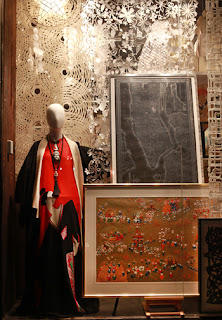Before the 1860s, Japanese clothing consisted entirely of a great variety of kimono.
They first appeared in the Jomon period, (14,500 B.C. ~ 300 B.C.), with no distinction
between male and female.
 |
| Japonism on display at 188 Galerie |
The kimono (きもの) (着物?) is a Japanese traditional garment. The word kimono, which actually means a "thing to wear" (ki "wear" and mono "thing"), has come to denote these full-length robes.
Kimono is always used in important festival or formal moments, it is the representative of polite and a very formal clothing.
 |
| Diagram showing distinct kimono parts. |
Kimono are T-shaped, straight-lined robes worn so that the hem falls to the ankle, with attached collars and long, wide sleeves.
Kimono are wrapped around the body, always with the left side over the right (except when dressing the dead for burial) and secured by a sash called an obi, which is tied at the back. Kimono are generally worn with traditional footwear (especially zōri or geta) and split-toe socks (tabi).
 |
| Traditional Japanese Doll |
Today, kimono are most often worn by women, and on special occasions. Traditionally, unmarried women wore a style of kimono called furisode, with almost floor-length sleeves, on special occasions. A few older women and even fewer men still wear the kimono on a daily basis.
 |
| Vintage Male Kimono |
Men wear the kimono most often at weddings, tea ceremonies, and other very special or very formal occasions. Professional sumo wrestlers are often seen in the kimono because they are required to wear traditional Japanese dress whenever appearing in public.
 |
| Vintage kimonos in their original paper warps. |
Kimonos range from extremely formal to casual. The level of formality of women's kimono is determined mostly by the pattern of the fabric, and color.
 |
| Traditional Uchikake Kimono |
Young women's kimonos have longer sleeves, signifying that they are not married, and tend to be more elaborate than similarly formal older women's kimono.
 |
| Couple in traditional wedding garb. |
Men's kimonos are usually one basic shape and are mainly worn in subdued colors. Formality is also determined by the type and color of accessories, the fabric, and the number or absence of kamon
(family crests), with five crests signifying extreme formality.
 |
| Traditional Japanese Doll |
Silk is the most desirable, and most formal, fabric. Kimonos made of fabrics such as cotton and polyester generally reflect a more casual style.
 |
| Vintage Hagoita Paddle |
Now on display at 188 Galerie, exclusively for sale by Vintage Black Label.



No comments:
Post a Comment